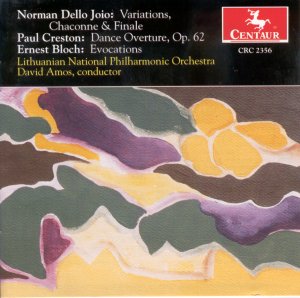These three classics of 20th century American
music together play for less than an hour.
The Dello Joio is his most accessible
concert work. Originally dubbed Three Symphonic Dances it
was premiered in Chicago by Fritz Reiner. It is the most substantial
piece here. Right from the start it radiates a glow which rises
to what I can best term a cool yet amiable spirituality. Apart
from one vulgar variation which breaks the mood this refrigerated
counterpart to Barber's Adagio works extremely well. The
character is well sustained into the warmer emotional heroics
of the Chaconne where the mood at times touches on Howard
Hanson's and Roy Harris's symphonic style. The Harris fingerprints
are very strong towards the end of the movement especially the
martellato blasts which lift and punctuate the closing
pages leading into the very brief finale - Allegro vivo.
That movement should be thought of in company with the flashing
energy of the Piston Second Symphony finale and Wirén's
Serenade for Strings. This is the first time I have come across
something of Dello Joio's that works as well as say Britten's
Simple Symphony or Janáček's
Sinfonietta. Dello Joio came from a musical family
and when hit by the Depression Norman's dance band supplemented
the family income. In this he was like Benjamin Frankel in London
though the two composers adopted completely different idioms:
Dello Joio kept to his tonal ‘True North’ while Frankel found
sustenance in Bergian dissonance albeit masterfully orchestrated.
Dance is a common thread through Creston's
music. Piece after piece are dance-linked and several of the movements
from his six symphonies are dance episodes. The overture is uproarious
without being vulgar. It has a high rhythmic charge and is good
entertainment music. It is the sort of thing that would go well
with the Kabalevsky Colas Breugnon overture, William Mathias's
ebullient Dance Overture, Alan Rawsthorne's Street
Corner, Bernstein's Candide, Copland's Outdoor Overture
and Arthur Butterworth's still unrecorded Mancunians overture.
It is more than mere high spirits as the poetic idyll of 6.09-9.11
demonstrates. The fairground jerkiness of the end suggests the
composer took his eyes off the ball for a little while and allowed
things to relax into the folksy vigour of Roy Harris's Folksong
Symphony (No. 4).
The Bloch is a serious reflection on Oriental
culture. It began life as Esquisses Orientales in 1930
but after much tinkering and revision over a period of eight years
emerged in its current form. The first movement (Contemplation)
is impressionistic, the second (Houang Ti), as befits a
God of War, rattles and blares with tearing gestures linked
to the saw-toothed fanfares from his 'Jewish' pieces. The third,
Springtime, is a pastoral idyll which resonates with voices
from Ravel's Daphnis et Chloe. Do not look for conscious
or obvious chinoiserie in this music. There is less of that than
in Bantock's delicate Four Chinese Pictures (pretty well
contemporaneous with the Bloch) or the Lambert or Bliss song cycles
of the 1920s.
Good and thoroughly detailed notes by Brendan
Wehrung.
This is a well judged collection. While we may
lament that a couple more works were not added the concert is
a very satisfying one which is likely to win new friends for all
three composers.
Rob Barnett
